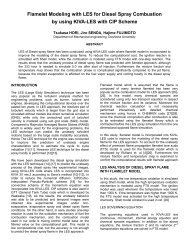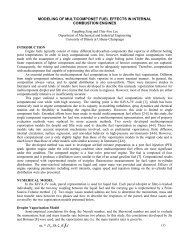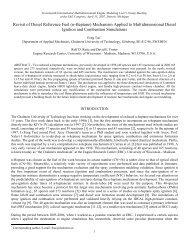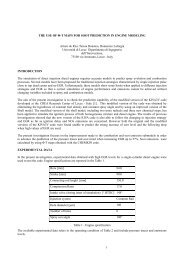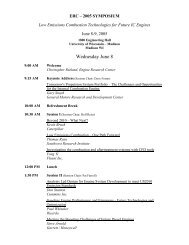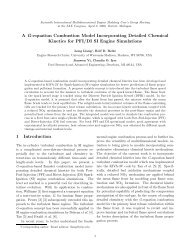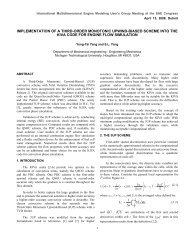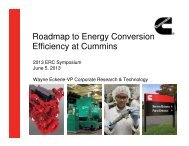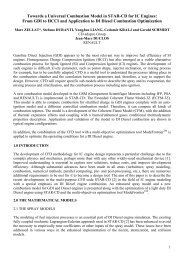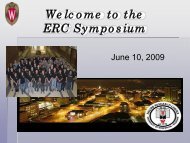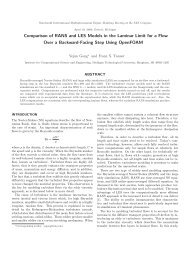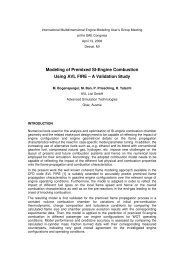Efficient Engine CFD with Detailed Chemistry
Efficient Engine CFD with Detailed Chemistry
Efficient Engine CFD with Detailed Chemistry
Create successful ePaper yourself
Turn your PDF publications into a flip-book with our unique Google optimized e-Paper software.
www.cd-adapco.com<br />
<strong>Efficient</strong> <strong>Engine</strong> <strong>CFD</strong><br />
<strong>with</strong> <strong>Detailed</strong> <strong>Chemistry</strong><br />
Harry Lehtiniemi and Rajesh Rawat<br />
CD-adapco<br />
Karin Fröjd and Fabian Mauss<br />
Digital Analysis of Reaction Systems
Challenges in <strong>CFD</strong> engine modeling<br />
• The flow is turbulent<br />
– Turbulence modeling required<br />
• Spray injection and evaporation occurs<br />
– Spray modeling is required<br />
• Autoignition, combustion, pollutant formation chemistry<br />
– Kinetic modeling required for various fuels<br />
– Soot, NOx models required<br />
<strong>Efficient</strong> <strong>Engine</strong> <strong>CFD</strong> <strong>with</strong> <strong>Detailed</strong> <strong>Chemistry</strong> 2
<strong>Efficient</strong> <strong>Engine</strong> <strong>CFD</strong> <strong>with</strong> <strong>Detailed</strong> <strong>Chemistry</strong><br />
Problem: Multidimensional modeling of turbulent reactive flow<br />
Turbulent flowfield<br />
Combustion<br />
Navier-Stokes equations ?<br />
<strong>Efficient</strong> <strong>Engine</strong> <strong>CFD</strong> <strong>with</strong> <strong>Detailed</strong> <strong>Chemistry</strong> 3
Outline<br />
• Species transport models<br />
– ”Laminar”<br />
– Techniques for speed-up<br />
– Incorporation of turbulence interactions<br />
• Flamelet models<br />
– Transient interactive flamelets<br />
– Transient flamelet progress variable model<br />
Requirements for industrial production simulations:<br />
<strong>Efficient</strong> handling of combustion chemistry<br />
Fully parallel flow simulation capabilities<br />
<strong>Efficient</strong> <strong>Engine</strong> <strong>CFD</strong> <strong>with</strong> <strong>Detailed</strong> <strong>Chemistry</strong> 4
STAR-CD and DARS-<strong>CFD</strong><br />
Problem: Multidimensional modeling of turbulent reactive flow<br />
Solution I:<br />
Turbulent flowfield<br />
Combustion<br />
Navier-Stokes equations<br />
Species transport<br />
<strong>Efficient</strong> <strong>Engine</strong> <strong>CFD</strong> <strong>with</strong> <strong>Detailed</strong> <strong>Chemistry</strong> 5
DARS-<strong>CFD</strong> – STAR-CD coupling<br />
STAR-CD:<br />
Species Y i<br />
0<br />
Enthalpy h<br />
Species Y i<br />
*<br />
Transport data D ij , , <br />
DARS-<strong>CFD</strong><br />
<strong>Efficient</strong> <strong>Engine</strong> <strong>CFD</strong> <strong>with</strong> <strong>Detailed</strong> <strong>Chemistry</strong> 6
DARS-<strong>CFD</strong> – STAR-CD coupling <strong>with</strong> DOLFA<br />
STAR-CD:<br />
DOLFA<br />
Database<br />
Species Y i<br />
0<br />
Enthalpy h<br />
DOLFA<br />
Species Y i<br />
*<br />
Transport data D ij , , <br />
DARS-<strong>CFD</strong><br />
<strong>Efficient</strong> <strong>Engine</strong> <strong>CFD</strong> <strong>with</strong> <strong>Detailed</strong> <strong>Chemistry</strong> 7
DARS-<strong>CFD</strong> – STAR-CD <strong>with</strong> turbulence interactions<br />
Two options for considering turbulence interactions:<br />
• Kong-Reitz model:<br />
• User coding:<br />
– Scaling of reaction rates<br />
– User can modify the reaction rates for all species<br />
<strong>Efficient</strong> <strong>Engine</strong> <strong>CFD</strong> <strong>with</strong> <strong>Detailed</strong> <strong>Chemistry</strong> 8
STAR-CD and Transient Flamelet Models<br />
Problem: Multidimensional modeling of turbulent reactive flow<br />
Solution II:<br />
Turbulent flowfield<br />
Combustion<br />
Navier-Stokes equations<br />
Flamelet modeling<br />
- Interactive<br />
- Transient library<br />
<strong>Efficient</strong> <strong>Engine</strong> <strong>CFD</strong> <strong>with</strong> <strong>Detailed</strong> <strong>Chemistry</strong> 9
Basics of the flamelet model<br />
Physical Coordinates Mixture fraction coordinate Z i<br />
tx , , x, x<br />
, ZZ , , Z<br />
1 2 3 2 3<br />
Flame: Surface of<br />
Stoichiometric mixture<br />
<strong>Efficient</strong> <strong>Engine</strong> <strong>CFD</strong> <strong>with</strong> <strong>Detailed</strong> <strong>Chemistry</strong> 10
Basics of the flamelet model<br />
Transport of a generic scalar<br />
Flamelet transform:<br />
Def. Scalar dissipation rate<br />
Equations in flamelet space<br />
<strong>Efficient</strong> <strong>Engine</strong> <strong>CFD</strong> <strong>with</strong> <strong>Detailed</strong> <strong>Chemistry</strong> 11
STAR-CD – TIF coupling<br />
STAR-CD<br />
Transport of Z, Z” 2 , h, I<br />
Z, Z” 2 T, W q<br />
Update h and <br />
Get cell local T and W q<br />
Perform species pdf integration<br />
Y i (Z)<br />
TIF<br />
2<br />
Yi<br />
Yi<br />
= + <br />
2 iWi<br />
t<br />
2 Z<br />
<strong>Efficient</strong> <strong>Engine</strong> <strong>CFD</strong> <strong>with</strong> <strong>Detailed</strong> <strong>Chemistry</strong> 12
Soot modeling <strong>with</strong> TIF<br />
• Turbulent diffusion flame (J. B. Moss et al. 1991) test case<br />
• Flowfield post-processed <strong>with</strong> TIF<br />
• <strong>Detailed</strong> kinetic soot model<br />
– Soot precursors: cyclopentapyrene and larger PAH<br />
– Surface growth: HACA <strong>with</strong> separate ring closure<br />
– Oxidation: O 2 and OH<br />
– Condensation and coagulation<br />
• Particle size distribution<br />
– Method of moments <strong>with</strong> interpolative closure (4 moments)<br />
– Sectional method (100 sections)<br />
F Mauss, K Netzell, and H Lehtiniemi, Combust Sci and Tech 178 (10-11) (2006) 1871-1885<br />
K Netzell, H Lehtiniemi, and F Mauss, Proc Combust Inst 31 (2007) 667-674<br />
<strong>Efficient</strong> <strong>Engine</strong> <strong>CFD</strong> <strong>with</strong> <strong>Detailed</strong> <strong>Chemistry</strong> 13
Soot modeling <strong>with</strong> TIF<br />
Centerline soot volume fracition<br />
]<br />
:<br />
[<br />
f v<br />
2 10 -6<br />
1.5 10 -6<br />
1 10 -6<br />
2.5 10 -6<br />
5 10 -7<br />
0 100 200 300 400<br />
0<br />
Height [mm]<br />
F Mauss, K Netzell, and H Lehtiniemi, Combust Sci and Tech 178 (10-11) (2006) 1871-1885<br />
K Netzell, H Lehtiniemi, and F Mauss, Proc Combust Inst 31 (2007) 667-674<br />
<strong>Efficient</strong> <strong>Engine</strong> <strong>CFD</strong> <strong>with</strong> <strong>Detailed</strong> <strong>Chemistry</strong> 14
Soot modeling <strong>with</strong> TIF<br />
Particle size distributions in the turbulent diffusion flame<br />
K Netzell, H Lehtiniemi, and F Mauss, Proc Combust Inst 31 (2007) 667-674<br />
<strong>Efficient</strong> <strong>Engine</strong> <strong>CFD</strong> <strong>with</strong> <strong>Detailed</strong> <strong>Chemistry</strong> 15
Transient flamelet progress variable model<br />
• Progress variable defined using chemical enthalpy integrated over the<br />
flamelet 1 N<br />
1<br />
s<br />
Ns<br />
h<br />
0 1 298<br />
( ( ) )<br />
0 1 298<br />
( ( ) 0)<br />
i , i<br />
Yi Z , dZ h<br />
i u<br />
Yi<br />
Z dZ<br />
= i<br />
, ,<br />
,<br />
=<br />
C =<br />
,<br />
1 N<br />
1<br />
s<br />
Ns<br />
h ( Y( Z) , ) dZ h ( Y( Z) , 0) dZ<br />
<br />
<br />
h h h<br />
<br />
0 i= 1 298,, ib i <br />
0 i=<br />
1 298,,<br />
iu i<br />
Transport eqn for chemical enthalpy<br />
2<br />
298 298 298<br />
+ v<br />
D =<br />
2 <br />
ihi<br />
, 298<br />
t x x<br />
i=<br />
1<br />
N s<br />
Transport eqn for the progress variable<br />
<br />
h<br />
+ v D = C<br />
<br />
t x x h /C t<br />
2<br />
C C C<br />
<br />
2<br />
<br />
<br />
<br />
Transform to Z – C space<br />
Z<br />
C<br />
<br />
= + +<br />
<br />
t Z t C t t<br />
Z<br />
<br />
C<br />
= +<br />
x Z x C x<br />
<br />
H Lehtiniemi, F Mauss, M Balthasar and I Magnusson, Combust Sci and Tech 178 (10-11) 2006 1977-1997<br />
298<br />
298<br />
<strong>Efficient</strong> <strong>Engine</strong> <strong>CFD</strong> <strong>with</strong> <strong>Detailed</strong> <strong>Chemistry</strong> 16
TFPV – Coupling to STAR-CD<br />
<strong>CFD</strong><br />
To library<br />
EGR, p( t), Tox( x, t),<br />
( x, t), C<br />
( x, t)<br />
Flamelet library module<br />
IdentifyFlamelet<br />
EGR, p( t), T ( x, t), ( x, t), C<br />
( x, t)<br />
ox<br />
C<br />
( x, t)<br />
hflamelet<br />
( T<br />
, Z)<br />
Transport of<br />
Z<br />
t Z<br />
t<br />
2<br />
( x, ), ( x, )<br />
<br />
1<br />
<br />
<br />
2<br />
hi( T ) YiP ( Z; Z , Z ) dZ<br />
0<br />
<br />
2<br />
CZZ , , , h<br />
h<br />
flamelet<br />
( T<br />
)<br />
T<br />
( x, t) , h<br />
( x, t)<br />
guess<br />
IterateTemperature<br />
T( x, t) = f ( T ( x, t), h( x, t), h<br />
( T))<br />
guess<br />
flamelet<br />
To <strong>CFD</strong><br />
T<br />
( x, t)<br />
T<br />
( x, t)<br />
C<br />
( x, t)<br />
<strong>Efficient</strong> <strong>Engine</strong> <strong>CFD</strong> <strong>with</strong> <strong>Detailed</strong> <strong>Chemistry</strong> 17
TFPV – Sample engine calculation<br />
Swept volume<br />
Compression ratio<br />
Number of nozzle holes<br />
Nozzle hole diameter<br />
Speed<br />
Fuel type<br />
Fuel amount<br />
<br />
Start of injection<br />
EGR ratio<br />
2.0 L<br />
15.3<br />
6<br />
0.2 mm<br />
1176 rpm<br />
Diesel<br />
74.35 mg<br />
1.24<br />
361 CA<br />
0.32<br />
H Lehtiniemi, F Mauss, M Balthasar and I Magnusson, SAE 2005-01-3855<br />
<strong>Efficient</strong> <strong>Engine</strong> <strong>CFD</strong> <strong>with</strong> <strong>Detailed</strong> <strong>Chemistry</strong> 18
TFPV – Sample engine calculation<br />
:<br />
[<br />
s<br />
s<br />
e<br />
r<br />
g<br />
o<br />
r<br />
P<br />
1<br />
0.8<br />
0.6<br />
0.4<br />
0.2<br />
Combustion progress<br />
___<br />
Max progress<br />
___<br />
Mean progress<br />
0<br />
350 360 370 380 390 400 410<br />
Crank angle [deg]<br />
Pressure and rate of heat release<br />
P<br />
[ 4 10 6 700<br />
3.5 10 6<br />
e<br />
600<br />
r 3 10 6<br />
500<br />
u<br />
s2.5 10 6<br />
400<br />
s<br />
2 10 6<br />
e<br />
300<br />
r1.5 10 6<br />
P<br />
1 10 6<br />
200<br />
5 10 5<br />
100<br />
0<br />
0<br />
350 360 370 380 390 400 410<br />
Crank angle [deg]<br />
H Lehtiniemi, F Mauss, M Balthasar and I Magnusson, SAE 2005-01-3855<br />
R<br />
a<br />
t<br />
e<br />
o<br />
f<br />
h<br />
e<br />
a<br />
t<br />
r<br />
e<br />
l<br />
<strong>Efficient</strong> <strong>Engine</strong> <strong>CFD</strong> <strong>with</strong> <strong>Detailed</strong> <strong>Chemistry</strong> 19
TFPV – Sample engine calculation CA 380<br />
Temperature Mixture fraction T [K] Z [-]<br />
2300<br />
0.4<br />
300<br />
0<br />
H Lehtiniemi, F Mauss, M Balthasar and I Magnusson, SAE 2005-01-3855<br />
<strong>Efficient</strong> <strong>Engine</strong> <strong>CFD</strong> <strong>with</strong> <strong>Detailed</strong> <strong>Chemistry</strong> 20
TFPV – Sample engine calculation, CA 385<br />
Temperature Mixture fraction T [K] Z [-]<br />
2300<br />
0.4<br />
300<br />
0<br />
H Lehtiniemi, F Mauss, M Balthasar and I Magnusson, SAE 2005-01-3855<br />
<strong>Efficient</strong> <strong>Engine</strong> <strong>CFD</strong> <strong>with</strong> <strong>Detailed</strong> <strong>Chemistry</strong> 21
TFPV – Sample engine calculation, CA 395<br />
Temperature Mixture fraction T [K] Z [-]<br />
2300<br />
0.4<br />
300<br />
0<br />
H Lehtiniemi, F Mauss, M Balthasar and I Magnusson, SAE 2005-01-3855<br />
<strong>Efficient</strong> <strong>Engine</strong> <strong>CFD</strong> <strong>with</strong> <strong>Detailed</strong> <strong>Chemistry</strong> 22
Summary<br />
• Strategies for efficiently incorporating detailed chemistry in<br />
multidimensional simulations were presented:<br />
– Direct integration of chemistry <strong>with</strong> DARS-<strong>CFD</strong><br />
– Flamelet approach<br />
» Transient interactive flamelet (TIF)<br />
» Transient flamelet progress variable model (TFPV)<br />
• The DARS-<strong>CFD</strong> model allows for<br />
– Turbulence interactions (Kong-Reitz) or user<br />
– Coupling to DOLFA<br />
– Full parallelism<br />
<strong>Efficient</strong> <strong>Engine</strong> <strong>CFD</strong> <strong>with</strong> <strong>Detailed</strong> <strong>Chemistry</strong> 23
Summary<br />
• The TIF model allows for<br />
– <strong>Efficient</strong> treatment of chemistry<br />
– Consistent handling of turbulence interactions<br />
– <strong>Efficient</strong> treatment of complex soot and emission chemistry<br />
– Fully parallel simulations<br />
• The TFPV model allows for<br />
– Consideration of effects of local inhomogeneities and local<br />
variations of scalar dissipation rate on the chemistry<br />
– Arbitrary large chemistry can be used in the tabulation <strong>with</strong>out<br />
influencing the <strong>CFD</strong> simulation CPU time<br />
– Coupling to library based emission models<br />
– Fully parallel simulations<br />
<strong>Efficient</strong> <strong>Engine</strong> <strong>CFD</strong> <strong>with</strong> <strong>Detailed</strong> <strong>Chemistry</strong> 24



